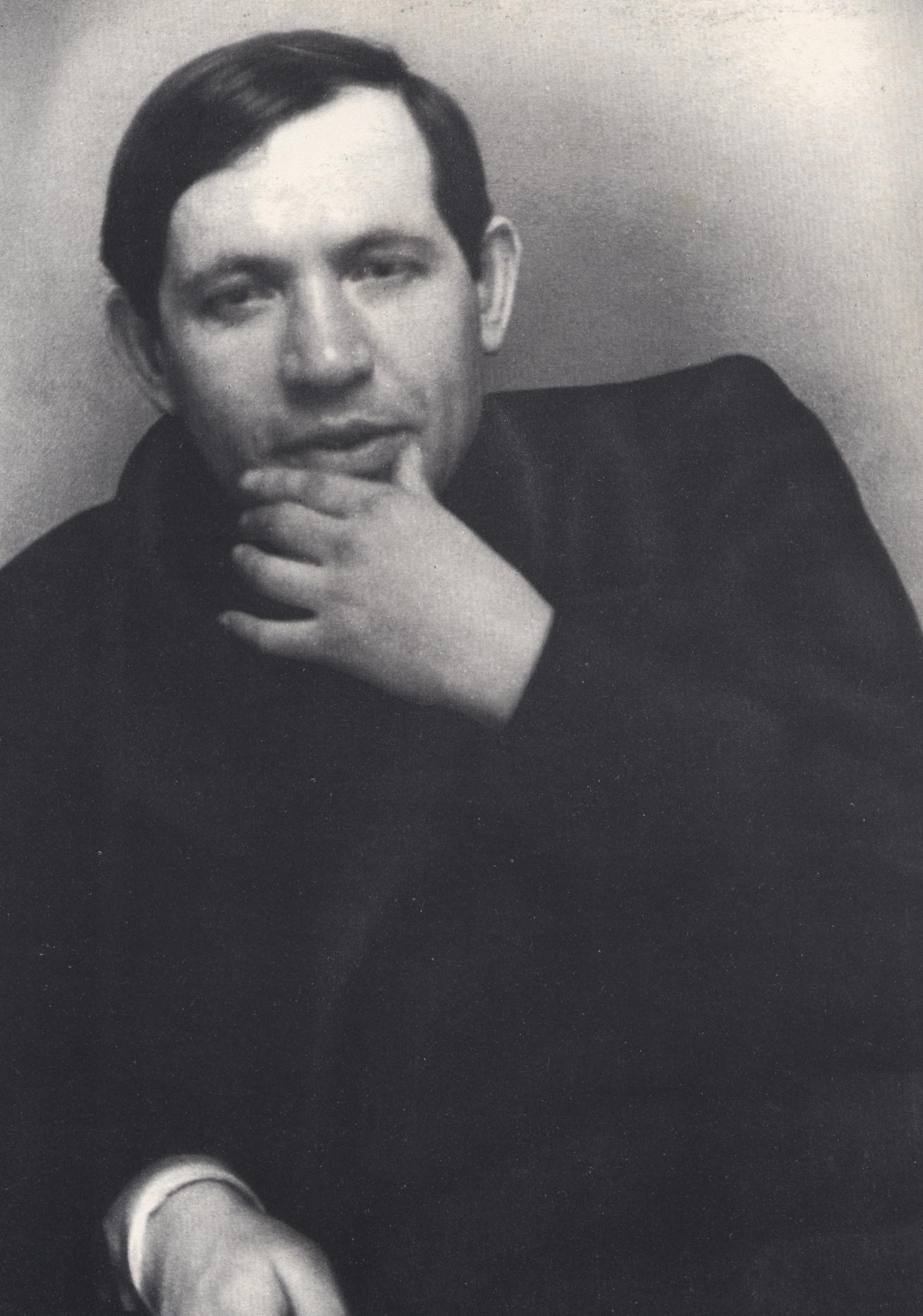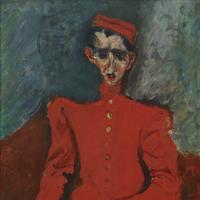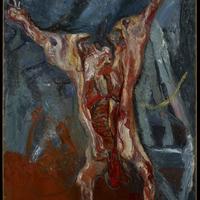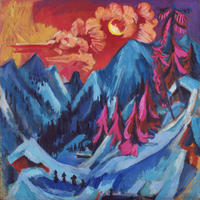More about Chaïm Soutine
Works by Chaïm Soutine
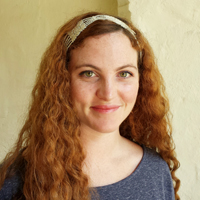
Sr. Contributor
You’ve really gotta paint some weird stuff to stand out in the Expressionism crowd and that’s just what Chaïm Soutine does.
Expressionism is a modernist movement meant to draw an emotional response from a viewer through the artist’s complete subjectivity. The result is beautiful and… expressive… usually invoking feelings of discomfort and confusion. Unworried about sounding cocky, Soutine's moody landscapes, distorted portraits, and aggressively visceral pictures of raw meat were self-described as “…heap[s] of shit, but better than Modigliani, Marc Chagall, and Krémènge.” Sh*t, no. Raw meat? Yes.
The terms “artistic temperament” and “struggling artist” could have been coined for Soutine. He never had money, was constantly begging for food and crashing on friend’s couches. He’d destroy canvases in fits of rage that he deemed unworthy of his talents (that couldn’t have helped his budget). He kept rotting meat lying around the house to paint, spraying it with fresh blood from time to time so he could keep the color right. One meat incident resulted in his neighbors calling the cops when they saw blood coming from beneath his front door. When police arrived Soutine went into a self-righteous lecture about his misunderstood art that would make any idealistic BFA student proud. A similar story has Chagall himself seeing the blood and running through the halls screaming, sacrebleu “Someone has killed Soutine!” Many say that Soutine’s frequent use of food and carcasses were a reflection of both his traditional Jewish upbringing in which food played an important role and a ravenous hunger caused by a stomach condition and poverty. Whatever the reason, dude gets major props for painting creepy meat about 30 years before Bacon.
Would you be surprised to hear that a guy who sprayed beef with blood in the name of art had a rough childhood? Soutine was born in what’s been described as a Lithuanian Jewish ghetto outside of Minsk in 1893. As the 10th of 11 children in a poor observant Jewish family Soutine showed interest in, and was discouraged from art at an early age. Discouraged is the nice way of phrasing it, he was in fact beaten by his and other families for his drawings, which they said defied rules set forth in Talmudic text. Ironically, some reports site the town’s disavowal of his art as what financed his studying the subject. The story goes that Soutine made a portrait of a Rabbi who then beat him up and the 1910 settlement provided Soutine the 25 rubles that sent him to the Academy of Fine Arts in Vilna.
With the help of friends and patrons Soutine survived destitution at school, sometimes selling paintings and stealing them back from people to maximize profit. Through these tricks and his already evident artistic genius he was able to scrape by and move to Paris in 1913 where he met his BFFL Modigliani. Together they painted doors and meat and made friends with art dealers, but he wouldn’t get his real break until 1923 when uber rich American collector Dr. Albert C. Barnes bought 60 of his pieces from a single show in Paris. Some versions of this story claim that after receiving the money the always poor Soutine immediately ran out of the gallery, hailed a cab, and took a 400 mile trip to Nice.
The patronage of Dr. Barnes suddenly made Soutine a “serious” artist. As a result he met wealthy interior designer Madeliene Castaing who, along with her husband, became his most avid supporters. They went so far as to let him live with them and shell out a bunch of money so he could have a show in Chicago. They would also help arrange his various hideouts from the Nazis during WWII. Unfortunately, their riches and good intentions weren’t enough to save him. The stress of life on the run exacerbated his ulcers and in August 1943 at the age of 50 he was transported from hiding to a hospital in Paris where he died. In a telling nod to his brilliance his funeral in Montparnasse was attended by art gods Picasso and Cocteau.

Contributor
Chaïm Soutine wasn't on the bleeding edge of the avant-garde of the 1920's and '30's, but his earlier work was experimental.
Trying to survive in a society plunging into World War II, Soutine later decided that this work was too experimental and tried to destroy all of it. Later, art writers would say that this "clogged and vehement" early work was his best. He studied Tintoretto, and Rembrandt, and his psyche absorbed those ideas and reworked them in the most unpredictable of ways. The Italian painter Amedeo Modigliani became a friend of Soutine's, introduced him to the art dealer Léopold Zborowski, and also made a portrait of him. Willem de Kooning especially enjoyed Soutine's work.
Soutine came from a desperately poor background in Smilavichy, a shtetl, or ghetto, of Minsk, Belarus, which was then part of the Russian Empire. His father was a clothes mender, and Soutine was the tenth of eleven children. In those days, Minsk was "beyond the pale of settlement," meaning that its inhabitants, Ashkenazi Jews, were forbidden by law to go outside of it. The general custom of the people was to avoid art, partly because the art world was so closely linked with Catholicism, and partly due to interpretations of the Oral Torah. One critic, Donald Kuspit, wrote that Soutine went from being a poor shtetl Jew to being an "absurd Jew—not a real Jew—by becoming a painter, which, after all, expressed the wish to escape the shtetl." The art historian Simon Schama said that the "only possible response" to this remark is "oy!" Or maybe even, "oy gevalt!" A Philadelphia collector, Albert Coombs Barnes, tracked down the destitute Soutine in Paris, suffering from a stomach ailment and sitting on a park bench. Barnes eventually purchased around one hundred of his works, and supported Soutine financially for the rest of his life.
In the shtetl it was typical for young children to carry chickens for several miles to the nearest kosher butcher, and chicken was often the most nutritious part of the diet of a family on the edge of malnutrition. The centrality of this experience is present in Soutine's work, as in his many paintings of the carcasses of animals, which were the model for Francis Bacon's "meat" theme. At his studio in the Rue du Mont Saint-Gotthard, Soutine hung a freshly butchered cow as a model, and had his assistant, Paulette Jourdain, keep it glistening with fresh blood. The cow posed beautifully, but the local fly community was equally excited about the cow, and there were so many flies that the neighbors called the police on Soutine. A true believer in art, Soutine lectured the police about his process.
A few years later, Soutine married one of his Russian models, Deborah Melnik, and had a daughter, Aimée. Sadly, he had doubts about his paternity, and Maury Povich was unavailable, so he left his wife and daughter. Aimée bore a striking resemblance to him, and she carried the Soutine surname throughout her brilliant painting career. Like millions of other men throughout the ages, Soutine was emotionally unable to take responsibility for his child, and even more unable to admit it.
David Sylvester, the father of the painter Cecily Brown, wrote that Soutine was "the artist of the pre-war period who had...the most to offer contemporary artists." In a TV interview, Francis Bacon said, "Soutine was a man with an enormous love of painting, who never drew, who painted his pictures directly and had deliberately never developed his technique. And he didn’t develop his technique because he thought he would keep the thing cleaner and rawer by that method."
The Jewish Museum in New York suggested that the meat series are "reminders of man’s darkest, cruellest and most primitive instincts" and asked, "couldn’t Soutine’s eruptive, vertiginous landscapes be construed as recollections of a ravaged Europe, or even as the foreshadowing of an apocalyptic post-atomic future?" Tragically, Soutine was not able to receive the medical care he needed for an ulcer whilst hiding from the fascists in the last few months of his life.
Sources
- Carl, Klaus H. Soutine. New York: Parkstone International, 2015.
- Farson, Daniel. The Gilded Gutter Life of Francis Bacon. London: Vintage, 1994.
- Gale, Matthew, and Chris Stephens. Francis Bacon. London: Tate Gallery, 2008.
- Hammer, Martin. "Found in Translation: Chaim Soutine and English Art." Modernist Cultures 5, no. 2 (2010): 218-242.
- Kleeblatt, Norman L., and Kenneth E. Silver. Chaim Soutine: An Expressionist in Paris. Munich and New York: Prestel Publications and Jewish Museum of New York, 1998.
- Meisler, Stanley. Shocking Paris: Soutine, Chagall and the Outsiders of Montparnasse. New York: Macmillan, 2015.
- Segev, Yael. "Christie's: Soutine $18 Million Pastry Chef Makes World Auction Record For The Artist." Jewish Business News, May 14, 2013, https://jewishbusinessnews.com/2013/05/14/christie-soutine-18-million-p…-
Featured Content
Here is what Wikipedia says about Chaïm Soutine
Chaïm Soutine (Russian: Хаим Соломонович Сутин, Khaïm Solomonovitch Sutin; Yiddish: חײם סוטין, Ḥaïm Soutin; 13 January 1893 – 9 August 1943) was a French painter of Belarusian-Jewish origin of the School of Paris, who made a major contribution to the expressionist movement while living and working in Paris.
Inspired by classic painting in the European tradition, exemplified by the works of Rembrandt, Chardin and Courbet, Soutine developed an individual style more concerned with shape, color, and texture than representation, which served as a bridge between more traditional approaches and the developing form of Abstract Expressionism.
Check out the full Wikipedia article about Chaïm Soutine

